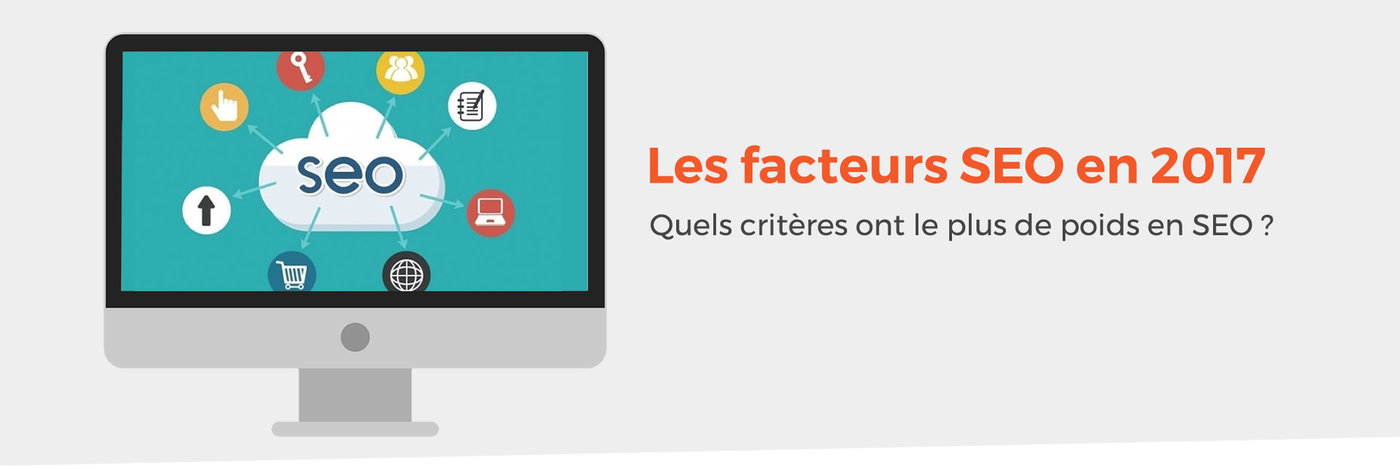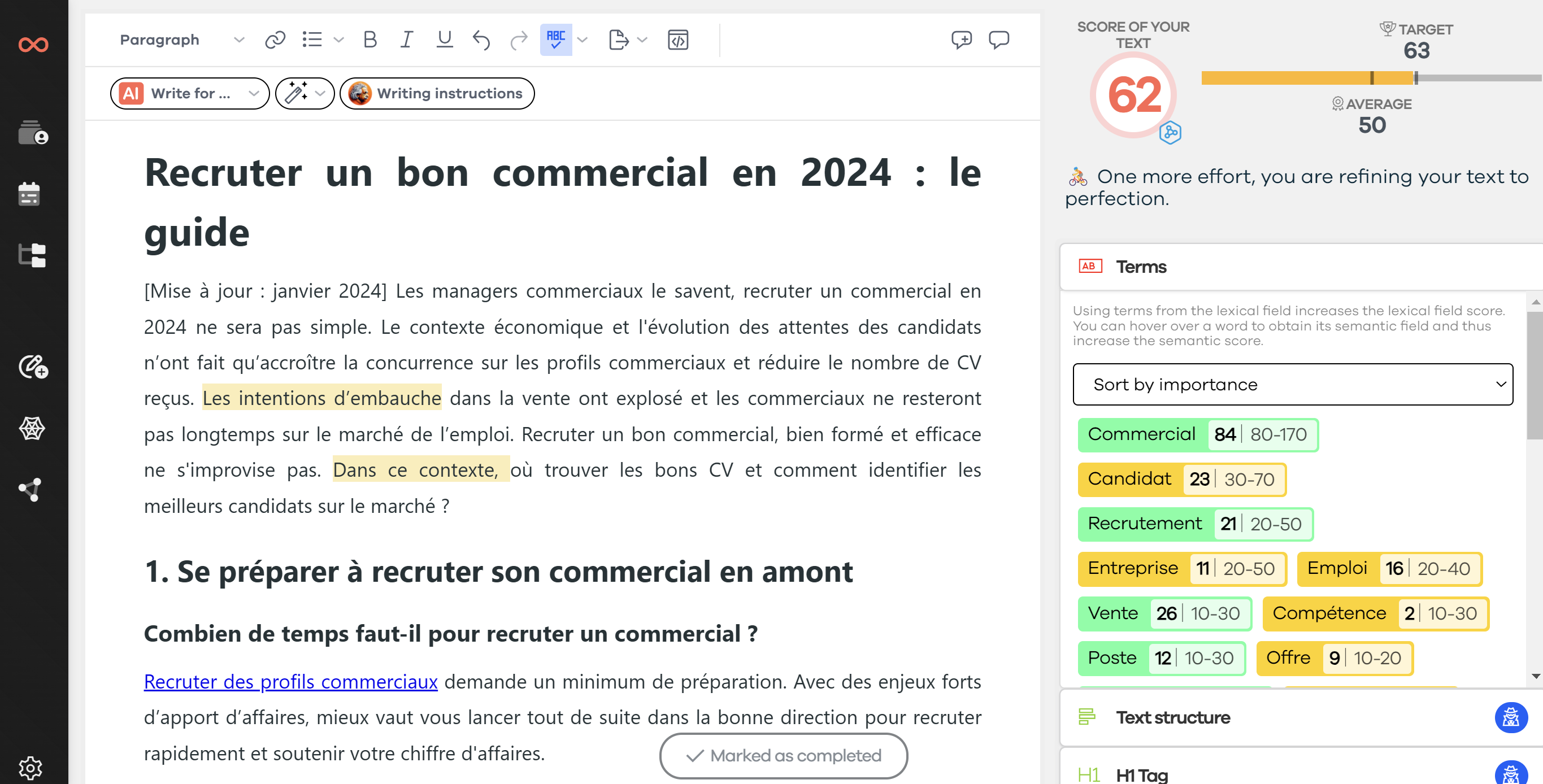After reading the article "SEO: The Most Important Criteria According to 140 SEO Professionals" on journaldunet, I wanted to react and provide my perspective on SEO factors.
❓ Why worry about ranking factors?
It is important to know the ranking criteria that have a major impact on your organic search performance. Through analysis, you can adapt your content, environment, and signals to maximize your chances of ranking and thus outperform your competitors.
Which criteria carry the most weight in SEO? Search ranking factors in 2021 are no longer universal. To succeed in organic search since the arrival of RankBrain and the upcoming "Google Page Experience" update in May 2021, you must create your own list of ranking factors. This list should adapt to the needs and specificities of your industry and audience.
The list you will find below is a good starting point. However, Rankbrain, Google's machine learning algorithm, now modifies the priority of these factors based on various signals: semantic theme, subject, and search intent. Ranking factors vary for each query.
Rankbrain performs "reverse engineering" of user behavior
RankBrain learns from user behavior. The algorithm studies the type of information users are looking for when they use specific keywords. To do this, Rankbrain collects SERP engagement data (how users interact with the search results page). It then uses this information to refine future results and prioritize relevant ranking factors. As a result, search ranking factors in 2021 are no longer universal but specific to each query.
💥 204 Google Ranking Criteria
There are over 200 Google ranking criteria for optimizing a website and its content. Although these SEO factors are largely known, the search engine's algorithm is kept secret. Their exact influence remains unknown. However, by working on as many of these elements as possible, you can hope to see your content appear at the top of the SERP. But don't overdo it either! Favor common sense and user experience to avoid over-optimization that could penalize your organic search performance.
Site-level SEO factors

1. Mobile-friendly site: For several years now, Google has prioritized the mobile version of websites (Mobile First Index). It is therefore essential to focus on its design rather than developing your site with only desktop display in mind.
2. Use of AMP format: In addition to speeding up the loading time of a web page, AMP (Accelerated Mobile Pages) seems to favor display in Google News on mobile. Take advantage of this to improve your visibility on the web!
3. Ease of use: To improve the user experience, your site must be easy to use and offer comfortable navigation. It has been observed that this factor influences the bounce rate and thus sends a negative message to search engines.
4. Loading speed based on HTML data: Whether it's Bing or Google, their indexing robots analyze the loading speed to establish the quality of a website and determine its ranking on the results pages.
5. Loading speed based on Google Chrome data: Unsurprisingly, Google uses its browser's statistics to determine the download speed of a site and conclude its quality.
6. Logical site structure: Your website's architecture should be designed to meet all the needs of users. To achieve this, creating an efficient topic cluster and implementing a complete keyword clustering are essential.
7. Presence and consistency of the sitemap: Although this criterion is not proven to improve SEO, it allows indexing robots to crawl your entire website more quickly, which is undoubtedly an asset for your search ranking.
8. Breadcrumb trail: This criterion mainly influences the user experience by allowing them to know exactly where they are in their navigation. This factor is also taken into account by search engines to categorize the information provided in the SERP.
9. Server location: Once again, this process speeds up the display of your site. In addition, it helps with local search ranking. If you are targeting an international audience, using a CDN (such as Cloudflare) is highly recommended.
10. Secure HTTPS connection: Originally, this technique only served to reassure users by publicly displaying the security of the site they were on. However, this element will be taken into account in the upcoming Google update scheduled for May 2021.
11. Trust index: TrustRank is considered by SEO professionals as a crucial indicator in SEO. It seems logical that trustworthy sites are displayed first in the search results pages.
12. Domain authority: The credibility of your site is also an important search ranking criterion for your positioning on search engines. If you are recognized as an expert in your field, you will be highlighted.
13. Site reputation linked to reviews: What better way to know the quality of a website than to simply take into account user feedback. Google and others have understood this and use this factor for organic search ranking.
14. Update frequency: Adding new content and updating existing texts seem to be taken into account by search engines. At the very least, this allows indexing robots to reconsider the positioning of a website based on the quality of the content offered.
15. Website accessibility: Errors related to server problems and maintenance duration can affect your SEO. Indeed, if the indexing robot passes at the same time or worse, encounters the same problem several times, it may temporarily de-index your site.
16. Unique metadata for each page: Although metadata does not have a direct effect on SEO, it has an indirect relationship related to click-through rates. Since each page deals with a unique subject, a simple adaptation allows for better results.
Page-level ranking factors

17. Page depth: The deeper a page is hidden, the less likely it is to rank well in the search results. Indeed, they seem less important to indexing robots, which could simply ignore them.
18. Priority in the sitemap: You can indicate in your sitemap.xml the priority of the pages you want to highlight. According to many SEO specialists, this seems to have a direct influence on their ranking.
19. Internal linking: By using internal links wisely, you help users find all the information they need. At the same time, you allow indexing robots to crawl as many pages of your website as possible.
20. Category affiliation: The more the category matches the content offered, the more valuable the page is in the eyes of Google and other search engines. So try to be clear and consistent in your URL chains.
21. URL length: The trend towards prioritizing pages with short URLs seems to be well established. However, there is no optimal length. However, be aware that 2,048 characters per URL is the maximum you can include in your sitemap.
22. Keyword in the URL: Although this SEO factor is considered minimal (see John Muller's video, in English), it slightly influences your search ranking. Therefore, when possible, do not hesitate to add a keyword to your page's address.
23. Clean and error-free HTML: A simple and error-free HTML code sends a quality signal to search engines. To check your CSS pages, you can use the W3C tool created to help developers with this complex task.
24. Ease of page navigation: By allowing users to navigate comfortably and intuitively, you improve the user experience. As this is one of Google's current priorities, it can only help your organic search ranking.
25. Table of contents: This is an excellent way to make navigation more enjoyable for your readers. It allows them to quickly find the information they want or to easily go back and forth.
26. Writing quality (grammar and spelling): This is an indicator of trust and quality that will reassure both users and search engines. Its influence on SEO is not proven, but it remains the best way to be credible on the web.
27. Readability level: To be able to answer mass queries, Google will logically favor a text that is easy to read. On the other hand, for more technical queries, a higher readability level may be favored. So, adapt your writing level to the subject you are dealing with.
28. Bullet and numbered lists: Pleasant to read and an excellent way to air out your text, the use of typographical symbols improves user comfort. Moreover, Google also seems to favor this type of content in their displayed results.
29. Unique content: Duplicate content is recognized as being penalized by search engines. Indeed, being unable to define which page to display, they simply prefer to de-index all identical content.
30. Canonical tag: Especially on an e-commerce site, it is extremely difficult not to have duplicate content. The canonical tag allows you to define the source page to avoid penalties related to duplicate content.
31. Content quality: To ensure that they provide results that fully meet users' queries, search engines want high-value content. So always try to offer texts that are more relevant than what your competitors are doing.
32. Content usefulness: Not only should your content be of high quality, but it must also (and especially) be useful. Your text must therefore answer as simply as possible a question or need that users actually have.
33. Comprehensive coverage of the subject: In order to best meet query intentions, try to cover the entire topic discussed. Expand your lexical field while providing all the information you deem necessary.
34. Relevance according to search intent: Your content must match the promises made in your titles. Otherwise, users and search engines will be disappointed, which will penalize the indexing of your page.
35. Age of the page: Although Google prefers to display recent content, it also likes to promote old pages that are frequently updated. This proves that your content is up-to-date and will meet users' expectations.
36. Update frequency: The more frequently pages are updated, the more you prove to search engines that your site is dynamic. This SEO criterion is widely recognized as favoring your organic search ranking.
37. Content length: Although long texts seem to rank better, there is no ideal content length. You simply need to adapt the size of your texts to the subject you are dealing with in order to best meet search intentions.
38. Keyword repetition: Once essential in SEO, the repetitive use of the same keyword is giving way to the advent of the lexical field. However, it is still essential to repeat a keyword in order to rank on it. Moderation is key!
39. Keyword in the first 100 words: When looking at the results on the first page of Google, it is invariably noticed that the main keyword is among the first 100 words. The good habit to adopt is to integrate it into your introduction (lead).
40. Cannibalization: There is a basic SEO rule that should not be broken: one keyword per page! If you do not follow this principle, you risk keyword cannibalization, which will prevent search engines from understanding your main theme.
41. Semantic field: In order to make indexing robots understand that the subject is covered in its entirety, you will favor a varied and complete vocabulary that encompasses the entire subject. To be able to meet this requirement, do not hesitate to use our semantic tool.
42. Sources and references: When dealing with a scientific or extremely technical subject, you should always cite your sources. This is at least what seems to emerge from their quality guide (Page Quality Rating Guideline, PDF in English).
43. Keyword in the "Title" tag: Although the “Title” tag no longer has as much SEO influence as before, it is still essential to include your keyword in it. Preferably, try to place it at the beginning of your meta title.
44. Keyword in the "H1" tag: Another hot zone, you should always indicate your main keyword in the “H1” tag. A good SEO practice can also be to indicate another variant than the one used in your meta title to try to improve your positioning on several queries.
45. Keyword in other headings: Depending on the length of your content and the number of subtitles, try to integrate your main keyword and associated keywords into your "H2", "H3", etc. tags.
46. Semantic field in headings: The more you make search engines understand that your content covers the entire subject, the more likely you are to rank well in the SERP. At the same time, you help your reader to easily navigate your page or article.
47. Key query in the meta description: This is an indirect SEO factor. Indeed, the meta description is not taken into account for the indexing of your page. However, it determines the click-through rate, which in turn influences your positioning and your permanence at the top of the displayed results.
48. TF-IDF: This SEO factor should be taken with a grain of salt! Although the TF-IDF is still sometimes used by search engines to analyze your content, this process is outdated and tends to disappear.
49. Image optimization: Loading speed is one of Google's current priorities, especially on mobile devices. By compressing your images and adapting their sizes and formats, you improve your chances of seeing your pages rise in the SERP.
50. Presence of multimedia: Content is not just textual! Images, videos, and podcasts are now essential for successful content marketing. By adding this type of content to your pages, you send a quality message to search engines.
51. Mobile display: As with your website, each of your pages must be adapted to mobile versions (phones and tablets). Being mobile-friendly is undoubtedly a requirement for search ranking today.
52. Hidden content on mobile devices: According to John Mueller (video in English), content that is not visible on mobile devices will not be indexed. However, there would be no penalty in this regard, even if essential content should always be displayed.
53. Hidden content under tabs: If a user has to click on a tab to display content, it seems that this content will not be indexed. Transparency seems to be an essential SEO factor in 2021.
54. Amount of information provided on the contact page: Google appreciates contact pages that provide a lot of information. This information must, of course, also correspond to the data provided on WhoIs.
55. Privacy policy page: With Google E-A-T and the growing need for reliability, the privacy policy page assures search engines of the legitimacy of your business. Do not neglect it!
56. Legal notices: For the same reasons mentioned in criterion 55, legal notices must appear on your website and be publicly accessible.
57. Number of incoming internal links: The more a page is targeted by internal links, the more it will be crawled by search engines. In addition, it gains more power each time another page refers to it.
58. Number of outgoing internal links: The outgoing internal link does not influence the source page but gives "link juice" to the destination page. However, the more outgoing links there are on the same page, the less influence they will have.
59. Broken links: Having too many broken links (leading to 404 errors) on a page sends a negative signal to Google. It then considers the site abandoned or poorly maintained, which reduces its trust index.
60. Affiliate links: Having affiliate links on your pages is not penalized by Google. However, if it notices that you have too many, it may delve deeper to check that the site is not solely dedicated to commercial purposes.
61. Outbound links to recognized sites: By citing recognized sites, you send a positive signal to search engines. They then consider you trustworthy and transparent, which seems essential today for good SEO.
62. Outbound links to a matching theme: If all the outbound links on your page match the theme discussed, you signal to Google that you are covering the subject in its entirety while taking care to provide comprehensive information to the user.
63. Number of outbound links: The number of outbound links does not directly influence your search ranking. However, if this is done too repetitively, Google will ensure that your site is not solely dedicated to spam.
Influence of incoming links (backlinks)

64. Incoming links from an old domain: Links from an old site have more influence than links from recent websites.
65. Age of the link: Links that persist are more recognized by search engines than recent links.
66. Domain authority (trust flow): The authority of the referring domain and the targeted site is an important SEO factor for the indexing of the pages concerned.
67. Citation flow: This concept was developed by Majestic. This search ranking criterion represents the potential positioning of a URL based on the quality and power of the links received.
68. Homepage authority: The number of quality links pointing to a website's homepage allows search engines to establish a unique importance of its quality.
69. Authority of the source page: If the page offering an external link to your site is widely recognized (PageRank), its influence has always been accepted as a reference in SEO.
70. Quality of backlinks: A link from an incomplete or poorly written text does not provide as many benefits as one from quality content.
71. Number of referring domains: The number of websites that have a link to another website has always been a predominant factor in organic search ranking.
72. Number of incoming links: Although quality takes precedence over quantity (as always in SEO), the number of incoming links remains a way to improve ranking. However, be careful not to overdo it, as this may appear as spam!
73. Number of pages targeted by links: The more pages you have that receive backlinks, the more search engines will consider you as a reference site.
74. Similarity of the referring domain: The concordance of subjects is essential in link building. The fact that domains dealing with similar subjects point to a site in the same universe helps with positioning in the SERP.
75. Links from competitor sites: It is not customary for competitors to recommend each other. If this is the case, then Google will take this as a positive signal for the indexing and ranking of the targeted page.
76. Backlinks from recognized sites: Some SEO experts believe that obtaining links from expert sites, in ".org" or ".edu", has more influence. However, this factor has never been proven.
77. Similarity of subjects between the two pages: It seems obvious that a page dealing with a theme pointing to another page talking about the same subject has more importance than if this were not the case.
78. Links from penalized sites: A link from a penalized site has a negative effect on SEO. That's why it's important to always check the origin of your backlinks.
79. Links from verified sites: It has become common to find blogs dedicated solely to promoting outbound links (fake blog). Google has noticed this and therefore favors links from verified sites.
80. Links from Wikipedia: Although these links are in "nofollow", some SEO professionals believe they are beneficial. They base this on the immense notoriety of the universal encyclopedia.
81. Links from forums: Little recognized, and even penalized if identified as "spam", links from forums are often in "nofollow" and provide very few benefits to their recipients.
82. Location on the page: The location of the link on the page is important. A link placed in the footer or a sidebar has less influence than a link directly placed in the content.
83. Location in the content: It seems that a link appearing at the beginning of a text has more power than if it were placed at the end.
84. Number of external links on the same page: Too many "dofollow" links on the same page dilute the PageRank (we then speak of "loss of juice").
85. Number of links from the same page: The fact that you put several links pointing to the same page in the same content does not provide more SEO value. Indeed, they are only counted as a single link.
86. Recommendations in guest articles: Although these links provide some value, they are not as recognized as natural links.
87. Variety of link anchors: Link anchors are a real means for search engines to combat spam or over-optimization. Their variety is therefore widely taken into account.
88. Text surrounding the link: The words placed directly before and after the link anchor help determine its relevance. This is therefore an important criterion for your organic search ranking.
89. Quality of the referring site's content: If the content of the source site is already recognized according to the editorial SEO criteria, its links will be more effective for the targeted sites.
90. Length of the referring site's content: The length of the content does not directly influence the power of the links. However, the referring text must still appear complete according to the factors listed above.
91. Speed of the link: Once again, loading speed is an essential factor for good search ranking. The speed of opening a link is therefore taken into account by search engines.
92. Diversity of backlink types: Having links from only one source (comments in blogs or forums) looks like spam. On the contrary, if the links come from a multitude of diverse origins, it is a good SEO indicator.
93. Links pointing to 301 pages: Links distributed to redirected pages (301) have less power than links that are not redirected.
94. Links from a 301 page: According to Matt Cutts (video in English), links from 301 code pages reduce link juice.
95. Links from geolocated domain names: Links from sites with geolocated extensions (.fr, .eu, etc.) help with local search ranking in the same country.
96. Direct link exchange: A direct link exchange (site A pointing to site B and vice versa) sends an alert signal to search engines, which can therefore have a negative effect on your organic search ranking.
97. Link triangulation: A site A that directs to a site B that in turn sends to a site C is the best way to perform a link exchange. Less obvious, this technique is not penalized by Google.
98. Link appreciated for answering different similar queries: When the same link displayed in the SERP is widely used to answer numerous similar searches, it shows that the subject has indeed been covered in its entirety.
⚠ There are no universal ranking criteria
I think it is nonsense to talk about "best SEO criteria" in 2021. RankBrain has made universal ranking factors obsolete. Sites that excel in the SERP today specifically meet the needs and preferences of the user. I think the only way to do this is to determine exactly what users are looking for for each keyword.
Need to go further?
If you need to delve deeper into the topic, the editorial team recommends the following 5 contents:

